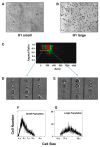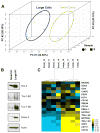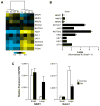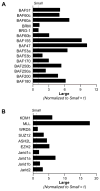Differential responses to retinoic acid and endocrine disruptor compounds of subpopulations within human embryonic stem cell lines
- PMID: 22906706
- PMCID: PMC3488128
- DOI: 10.1016/j.diff.2012.07.006
Differential responses to retinoic acid and endocrine disruptor compounds of subpopulations within human embryonic stem cell lines
Abstract
The heterogeneous nature of stem cells is an important issue in both research and therapeutic use in terms of directing cell lineage differentiation pathways, as well as self-renewal properties. Using flow cytometry we have identified two distinct subpopulations by size, large and small, within cultures of human embryonic stem (hES) cell lines. These two cell populations respond differentially to retinoic acid (RA) differentiation and several endocrine disruptor compounds (EDC). The large cell population responds to retinoic acid differentiation with greater than a 50% reduction in cell number and loss of Oct-4 expression, whereas the number of the small cell population does not change and Oct-4 protein expression is maintained. In addition, four estrogenic compounds altered SSEA-3 expression differentially between the two cell subpopulations changing their ratios relative to each other. Both populations express stem cell markers Oct-4, Nanog, Tra-1-60, Tra-1-80 and SSEA-4, but express low levels of differentiation markers common to the three germ layers. Cloning studies indicate that both populations can revive the parental population. Furthermore, whole genome microarray identified approximately 400 genes with significantly different expression between the two populations (p<0.01). We propose the differential response to RA in these populations is due to differential gene expression of Notch signaling members, CoupTF1 and CoupTF2, chromatin remodeling and histone modifying genes that render the small population resistant to RA differentiation. The findings that hES cells exist as heterogeneous populations with distinct responses to differentiation signals and environmental stimuli will be relevant for their use for drug discovery and disease therapy.
Published by Elsevier B.V.
Figures









Similar articles
-
Erythro-9-(2-hydroxy-3-nonyl)adenine (EHNA) blocks differentiation and maintains the expression of pluripotency markers in human embryonic stem cells.Biochem J. 2010 Dec 15;432(3):575-84. doi: 10.1042/BJ20100726. Biochem J. 2010. PMID: 20923411
-
Nocodazole treatment decreases expression of pluripotency markers Nanog and Oct4 in human embryonic stem cells.PLoS One. 2011 Apr 29;6(4):e19114. doi: 10.1371/journal.pone.0019114. PLoS One. 2011. PMID: 21559451 Free PMC article.
-
Stable expression of FoxA1 promotes pluripotent P19 embryonal carcinoma cells to be neural stem-like cells.Gene Expr. 2012;15(4):153-62. doi: 10.3727/105221612x13372578119571. Gene Expr. 2012. PMID: 22783724 Free PMC article.
-
[OCT4 and NANOG are the key genes in the system of pluripotency maintenance in mammalian cells].Genetika. 2008 Dec;44(12):1589-608. Genetika. 2008. PMID: 19178078 Review. Russian.
-
A short history of pluripotent stem cells markers.Stem Cell Reports. 2024 Jan 9;19(1):1-10. doi: 10.1016/j.stemcr.2023.11.012. Epub 2023 Dec 28. Stem Cell Reports. 2024. PMID: 38157849 Free PMC article. Review.
Cited by
-
Gestational exposure to chlordecone promotes transgenerational changes in the murine reproductive system of males.Sci Rep. 2018 Jul 6;8(1):10274. doi: 10.1038/s41598-018-28670-w. Sci Rep. 2018. PMID: 29980752 Free PMC article.
-
Actions of endocrine-disrupting chemicals on stem/progenitor cells during development and disease.Endocr Relat Cancer. 2014 Mar 12;21(2):T1-12. doi: 10.1530/ERC-13-0360. Print 2014 Apr. Endocr Relat Cancer. 2014. PMID: 24280134 Free PMC article. Review.
-
A Combination of Culture Conditions and Gene Expression Analysis Can Be Used to Investigate and Predict hES Cell Differentiation Potential towards Male Gonadal Cells.PLoS One. 2015 Dec 2;10(12):e0144029. doi: 10.1371/journal.pone.0144029. eCollection 2015. PLoS One. 2015. PMID: 26630562 Free PMC article.
-
Hormonal regulation of hematopoietic stem cells and their niche: a focus on estrogen.Int J Stem Cells. 2015 May;8(1):18-23. doi: 10.15283/ijsc.2015.8.1.18. Int J Stem Cells. 2015. PMID: 26019751 Free PMC article. Review.
-
High-content screen in human pluripotent cells identifies miRNA-regulated pathways controlling pluripotency and differentiation.Stem Cell Res Ther. 2019 Jul 8;10(1):202. doi: 10.1186/s13287-019-1318-6. Stem Cell Res Ther. 2019. PMID: 31287022 Free PMC article.
References
-
- Adamo A, Barrero MJ, Belmonte JC. LSD1 and pluripotency: a new player in the network. Cell Cycle. 2011a;10:3215–3216. - PubMed
-
- Adamo A, Sese B, Boue S, Castano J, Paramonov I, Barrero MJ, Izpisua Belmonte JC. LSD1 regulates the balance between self-renewal and differentiation in human embryonic stem cells. Nature cell biology. 2011b;13:652–659. - PubMed
-
- Ahn SE, Kim S, Park KH, Moon SH, Lee HJ, Kim GJ, Lee YJ, Cha KY, Chung HM. Primary bone-derived cells induce osteogenic differentiation without exogenous factors in human embryonic stem cells. Biochem Biophys Res Commun. 2006;340:403–408. - PubMed
-
- Ali S, Buluwela L, Coombes RC. Antiestrogens and their therapeutic applications in breast cancer and other diseases. Annu Rev Med. 2011;62:217–232. - PubMed
-
- Allegrucci C, Wu YZ, Thurston A, Denning CN, Priddle H, Mummery CL, Ward-van Oostwaard D, Andrews PW, Stojkovic M, Smith N, Parkin T, Jones ME, Warren G, Yu L, Brena RM, Plass C, Young LE. Restriction landmark genome scanning identifies culture-induced DNA methylation instability in the human embryonic stem cell epigenome. Hum Mol Genet. 2007;16:1253–1268. - PubMed
Publication types
MeSH terms
Substances
Grants and funding
LinkOut - more resources
Full Text Sources
Molecular Biology Databases
Research Materials

